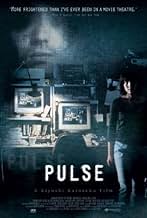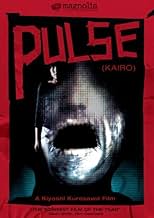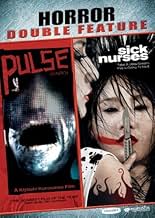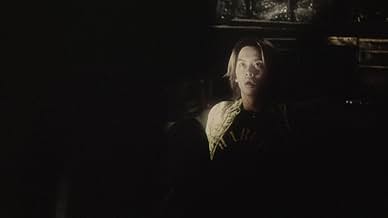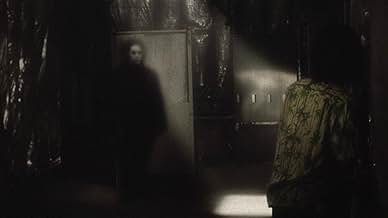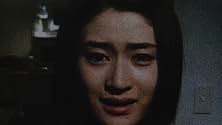Due gruppi di persone scoprono prove che suggeriscono che gli spiriti stiano cercando di invadere il mondo umano tramite Internet.Due gruppi di persone scoprono prove che suggeriscono che gli spiriti stiano cercando di invadere il mondo umano tramite Internet.Due gruppi di persone scoprono prove che suggeriscono che gli spiriti stiano cercando di invadere il mondo umano tramite Internet.
- Regia
- Sceneggiatura
- Star
- Premi
- 3 vittorie e 3 candidature totali
Recensioni in evidenza
This film starts out well, doing all the right stuff. It had me going for awhile.
But it get's slower, and slower, and slower--not to mention murkier. It is one of those films that would have worked fine as a 90 minute movie--even with some flaws.
But , anyway, this film goes on for about two hours, long after the viewer's interest has begun to wander and you've started scratching your head, wondering exactly what is happening.
Toward the end it kind of degenerates into overly long scenes of people running around in blasted, derelict industrial buildings breathing very hard into their microphones and shouting uninspired, predictable dialogue.
Some things just aren't very dramatic. Longish scenes of people poking around in pretty much abandoned industrial settings looking for stuff and breathing hard into their microphones isn't dramatic.
By the end, we are working our way through a checklist of horror movie clichés in excruciatingly slow motion. Ancient horror movie clichés have to be executed with a certain cleverness, a certain panache, and perhaps a little inventive camera work/cutting. Some snappy dialogue, some attitude. Or maybe you just have to get them out of the way fast. That's not what happens in this film.
The premise is rather interesting, but some of the exposition kind of conflicts with the stated premise--unless the stated premise was a red-herring. It's hard to tell from what they give you on screen and the film didn't motivate me to try to figure it out.
So, nice idea, good start ... really, really slow, pretty much unimaginative ending.
Maybe if they had had a bigger special effects budget ...
But it get's slower, and slower, and slower--not to mention murkier. It is one of those films that would have worked fine as a 90 minute movie--even with some flaws.
But , anyway, this film goes on for about two hours, long after the viewer's interest has begun to wander and you've started scratching your head, wondering exactly what is happening.
Toward the end it kind of degenerates into overly long scenes of people running around in blasted, derelict industrial buildings breathing very hard into their microphones and shouting uninspired, predictable dialogue.
Some things just aren't very dramatic. Longish scenes of people poking around in pretty much abandoned industrial settings looking for stuff and breathing hard into their microphones isn't dramatic.
By the end, we are working our way through a checklist of horror movie clichés in excruciatingly slow motion. Ancient horror movie clichés have to be executed with a certain cleverness, a certain panache, and perhaps a little inventive camera work/cutting. Some snappy dialogue, some attitude. Or maybe you just have to get them out of the way fast. That's not what happens in this film.
The premise is rather interesting, but some of the exposition kind of conflicts with the stated premise--unless the stated premise was a red-herring. It's hard to tell from what they give you on screen and the film didn't motivate me to try to figure it out.
So, nice idea, good start ... really, really slow, pretty much unimaginative ending.
Maybe if they had had a bigger special effects budget ...
I really like the slow and ominous atmosphere of Kairo, especially its depiction of Japan's late 90s and early 2000s aesthetics, including early internet culture and architectural design. The film features some excellent decor shots that enhance its eerie and nostalgic feel.
Fun fact: Kiyoshi Kurosawa, known for his work in horror, actually started his career directing pink films, which are a genre of Japanese softcore adult movies. This diverse background contributed to his unique approach to creating tension and atmosphere in his later works.
I give this film a 6/10 mostly because i love the aesthetics from the early 2000s.
-Concept (Idea Premise, Worldbuilding, Theme) 7.0 -Plot (A,B,C, Writing) 6.0 -Acting 5.8 -Dialogue(Character development, Plot advancement, Natural-sounding, Consistency, Looping(ADR)) 5.6 -Fun 5.2 -Decor (Aesthetic, Graphics VFX, Scenery/Location, Scenes, Shots, Stage Set, Mise en Scène, Directing) 8.2 -Overall 6.3.
Fun fact: Kiyoshi Kurosawa, known for his work in horror, actually started his career directing pink films, which are a genre of Japanese softcore adult movies. This diverse background contributed to his unique approach to creating tension and atmosphere in his later works.
I give this film a 6/10 mostly because i love the aesthetics from the early 2000s.
-Concept (Idea Premise, Worldbuilding, Theme) 7.0 -Plot (A,B,C, Writing) 6.0 -Acting 5.8 -Dialogue(Character development, Plot advancement, Natural-sounding, Consistency, Looping(ADR)) 5.6 -Fun 5.2 -Decor (Aesthetic, Graphics VFX, Scenery/Location, Scenes, Shots, Stage Set, Mise en Scène, Directing) 8.2 -Overall 6.3.
A cold, creepy & confounding horror that unfortunately overstays its welcome in the end, Pulse (also known as Kairo) is downright eerie during the first act as it creates an ominous aura of dread & uncertainty with its uncanny premise, freaky imagery & inexplicable body counts but thanks to its glacial pace, uninviting quality & overlong runtime, sitting through it is a slog.
Written & directed by Kiyoshi Kurosawa, the film is devoid of cheap tricks & clichéd elements that plague most horror films and makes for an interesting examination of isolation & loneliness. Kurosawa allows plenty of space for the plot to unravel but it also slows down the narrative by a considerable extent. And with no deftly scripted character to latch on to, it becomes an infuriating journey.
Also lessening the overall impact is the uneven script & seemingly opaque structure that has our curiosity at first but slowly loses it as the story crawls towards the finish line. An added focus on a single storyline instead of two, a steadier pace than usual & a bit more transparency could've enhanced the overall experience without diluting its effectiveness. It is 119 mins long on paper but feels twice as lengthy.
Overall, Pulse isn't going to appeal to everyone's taste but for those who have the endurance to sit through this chore and patiently connect with what Kurosawa was going for here may find the ride rewarding. The snail-paced narration is probably a deliberate choice but it also alienates the film from a wider viewership. Nonetheless, for those who are sick & tired of the typical, predictable & thinly layered horror films, Pulse might just be what they are looking for.
Written & directed by Kiyoshi Kurosawa, the film is devoid of cheap tricks & clichéd elements that plague most horror films and makes for an interesting examination of isolation & loneliness. Kurosawa allows plenty of space for the plot to unravel but it also slows down the narrative by a considerable extent. And with no deftly scripted character to latch on to, it becomes an infuriating journey.
Also lessening the overall impact is the uneven script & seemingly opaque structure that has our curiosity at first but slowly loses it as the story crawls towards the finish line. An added focus on a single storyline instead of two, a steadier pace than usual & a bit more transparency could've enhanced the overall experience without diluting its effectiveness. It is 119 mins long on paper but feels twice as lengthy.
Overall, Pulse isn't going to appeal to everyone's taste but for those who have the endurance to sit through this chore and patiently connect with what Kurosawa was going for here may find the ride rewarding. The snail-paced narration is probably a deliberate choice but it also alienates the film from a wider viewership. Nonetheless, for those who are sick & tired of the typical, predictable & thinly layered horror films, Pulse might just be what they are looking for.
A group of young people in Tokyo begin to experience strange phenomena involving missing co-workers and friends, technological breakdown, and a mysterious website which asks the compelling question, "Do you want to meet a ghost?"
Director Kiyoshi Kurosawa spent years working in the world of "pink" films and direct-to-video movies. He was at this time best known in the west for "Cure" (1997), though it was "Pulse" that would make him an international sensation. Assisting him is cinematographer Junichiro Hayashi, known for two other J-horror modern classics, "Ring" and "Dark Water".
"Pulse" was released at the right time for American audiences to latch on to. The American version of "The Ring" came out in 2002, and sparked a wider interest in Japanese horror, kicking off a wave of remakes. This also helped get the originals a wider distribution in the States -- "Pulse" being among those, as well as "Audition" and many of the Takashi Miike films that had previously been very niche.
Kurosawa uses this film not just to tell a good ghost story, but to explore "the horror of isolation" in a world of increased inter-connectivity. With its dreary, depressing color palette and empty space, we find this story about the Internet to truly be about loneliness. Whether intentional or not, it is a clever social commentary that may be more true today (2017) than it was at the time.
Some early reviews were critical because the film is heavier on style than substance and the narrative is not completely coherent. But since then, praise has only grown. In 2012, Jaime Christley of Slant magazine listed the film as one of the greatest of all time. In the early 2010s, Time Out conducted a poll with several authors, directors, actors and critics who have worked within the horror genre to vote for their top horror films. "Pulse" placed at number 65 on their top 100 list.
The Arrow Video Blu-ray is a fine package and a great excuse to re-visit this film. Contents include (but are not limited to) new interviews with writer/director Kiyoshi Kurosawa (at an astounding 43 minutes!), actor Show Aikawa and cinematographer Junichiro Hayashi (24 minutes); "The Horror of Isolation", a new video appreciation featuring Adam Wingard and Simon Barrett; an archive 'making of' documentary, plus four archive behind-the-scenes featurettes.
Director Kiyoshi Kurosawa spent years working in the world of "pink" films and direct-to-video movies. He was at this time best known in the west for "Cure" (1997), though it was "Pulse" that would make him an international sensation. Assisting him is cinematographer Junichiro Hayashi, known for two other J-horror modern classics, "Ring" and "Dark Water".
"Pulse" was released at the right time for American audiences to latch on to. The American version of "The Ring" came out in 2002, and sparked a wider interest in Japanese horror, kicking off a wave of remakes. This also helped get the originals a wider distribution in the States -- "Pulse" being among those, as well as "Audition" and many of the Takashi Miike films that had previously been very niche.
Kurosawa uses this film not just to tell a good ghost story, but to explore "the horror of isolation" in a world of increased inter-connectivity. With its dreary, depressing color palette and empty space, we find this story about the Internet to truly be about loneliness. Whether intentional or not, it is a clever social commentary that may be more true today (2017) than it was at the time.
Some early reviews were critical because the film is heavier on style than substance and the narrative is not completely coherent. But since then, praise has only grown. In 2012, Jaime Christley of Slant magazine listed the film as one of the greatest of all time. In the early 2010s, Time Out conducted a poll with several authors, directors, actors and critics who have worked within the horror genre to vote for their top horror films. "Pulse" placed at number 65 on their top 100 list.
The Arrow Video Blu-ray is a fine package and a great excuse to re-visit this film. Contents include (but are not limited to) new interviews with writer/director Kiyoshi Kurosawa (at an astounding 43 minutes!), actor Show Aikawa and cinematographer Junichiro Hayashi (24 minutes); "The Horror of Isolation", a new video appreciation featuring Adam Wingard and Simon Barrett; an archive 'making of' documentary, plus four archive behind-the-scenes featurettes.
This film works on many levels. What's odd is that one place it is weak in is the plot - it does somewhat tie it all up and make sense but my main point is it doesnt really matter - the director set out to make a scary ghost story and that it is! I see horror films from all over the world so I am pretty jaded when it comes to something "scaring" me but this film has many sequences that truly are frightening and disturbing. Some of the images have stayed with me for weeks. The lighting, the art direction and the use of muted colors (aside from reds used effectively)all make up for a creepy, eerie visual. I have to laugh at the arrogance of some of the comments on this and other "horror" films that claim since it didnt scare them the film is NOT SCARY. That is b.s. What scares one person may not scare another. You can say the piece didn't scare you but to make such a sweeping statement is vain. I personally didn't like any of the Friday of 13th movies, but obviously those films work on some level for millions of people. This film is so non-American in it's pace and core that that is what might turn off some viewers, but that's what I loved about it. The director just sets up the camera and keeps it on a space and then has things slowly emerge from the sides - he has you start to look and scope and wonder if you are REALLY seeing something as opposed to the lazy, bloated SHOCK moment of most US horror films. There are moments when people are confronted by visions/images of ghosts that move and terrorize just like real dreams - slow movements, awkward movements as the ghost approaches you. Terrifying. The film definitely doesn't know how to wrap it all up but in many ways, I found this film even scarier than the original RING. Well made ghost story. Seek it out, fans.
Lo sapevi?
- QuizTakashi Miike has said that this is the only film that has frightened him as an adult.
- BlooperRyosuke is typing in a numerical password to log in to his computer to watch videos on the dark web as shown on his screen. When it cuts to a shot of him typing on his keyboard however, he is pressing letters instead of numbers.
- Citazioni
Ghost: Death was... eternal loneliness.
- Versioni alternativeRemade in America with the same (English) title, starring Kristen Bell, in 2006.
- ConnessioniEdited into Pulse (2006)
- Colonne sonoreHane Lay Down My Arms
Performed by Cocco
I più visti
Accedi per valutare e creare un elenco di titoli salvati per ottenere consigli personalizzati
- How long is Pulse?Powered by Alexa
Dettagli
Botteghino
- Lordo Stati Uniti e Canada
- 51.420 USD
- Fine settimana di apertura Stati Uniti e Canada
- 7250 USD
- 13 nov 2005
- Lordo in tutto il mondo
- 327.338 USD
Contribuisci a questa pagina
Suggerisci una modifica o aggiungi i contenuti mancanti







